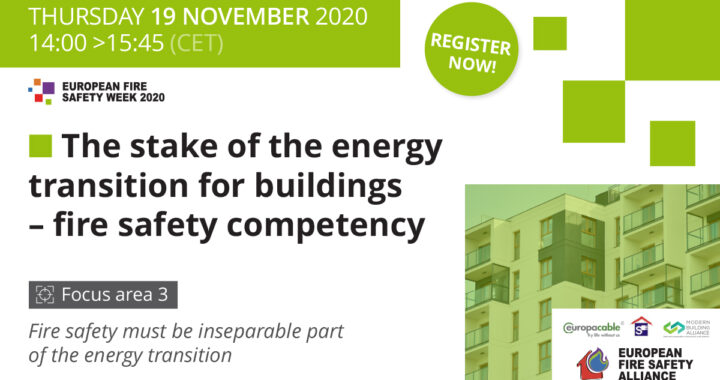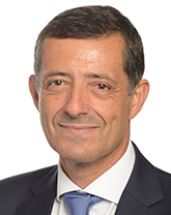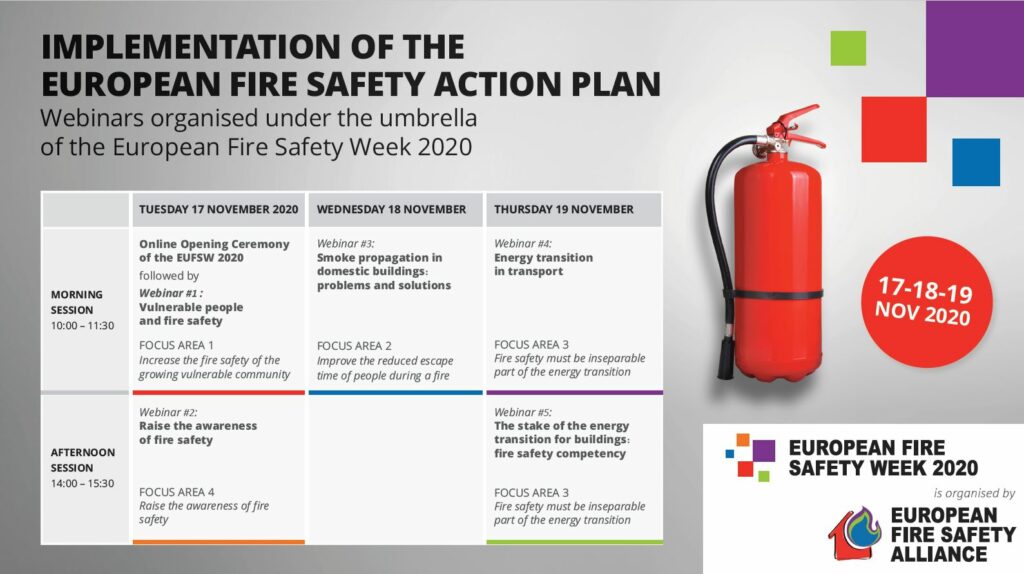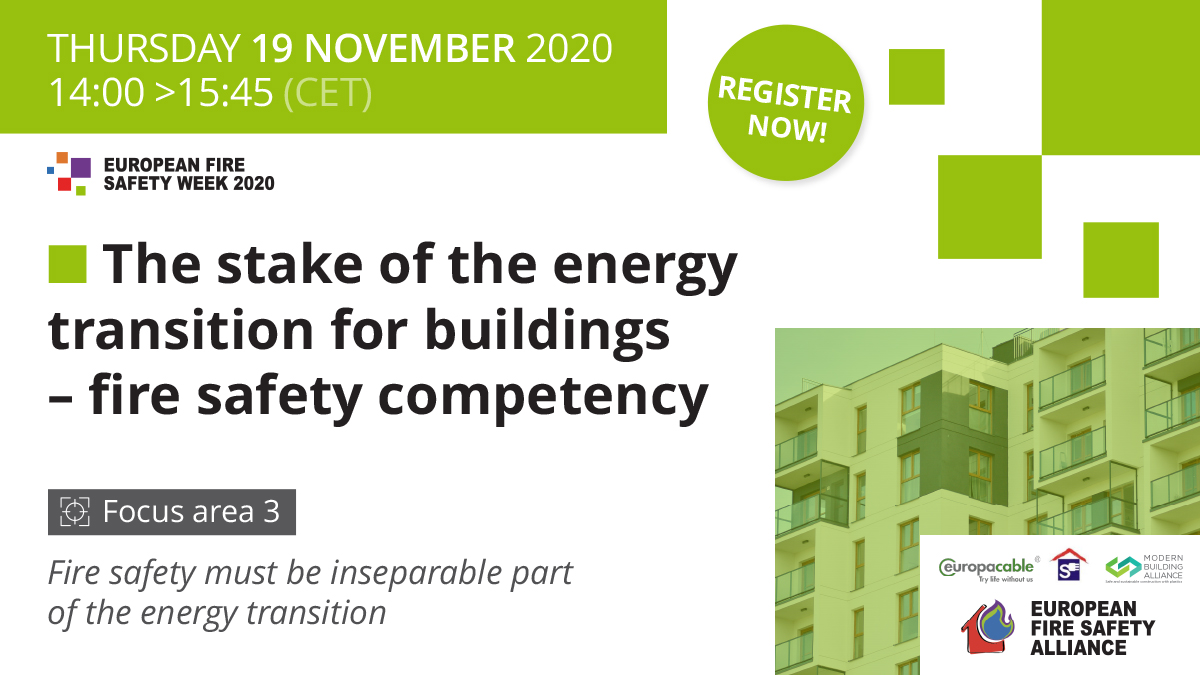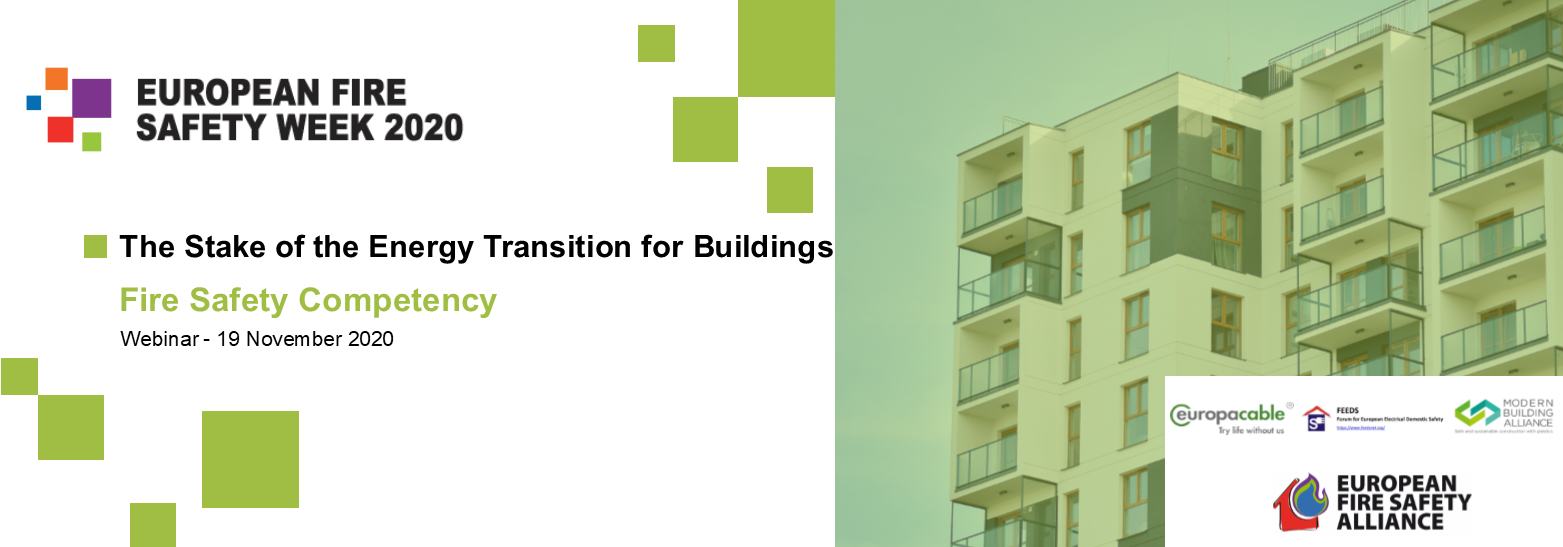
The stake of the Energy Transition for Buildings - Fire Safety Competency
About the European Fire Safety Week 2020
For the second edition of the European Fire Safety Week, the European Fire Safety Alliance (EuroFSA) teamed up with the Modern Building Alliance, Europacable and the FEEDS to address the stake of fire safety of buildings in the context of the energy transition. The webinar boasted more than 365 registrations, attracted by the high level expertise of the speakers announced in the programme.
Presentations and biographies of speakers
Outcome: Graphic Recording
Context
The energy transition and renovation wave are two major elements of the EU Green Deal. Both will enhance climate protection and economic recovery while improving the quality of life of EU citizens.
The energy transition is bringing structural change to global energy production and consumption. In this context, the building stock has a central position. Its sustainable transformation will include the electrification (e-mobility, solar panels, domestic batteries, etc.) and decentralisation of energy production.
The trend towards higher energy efficiency, sustainability and circularity involves the use of new materials, new construction systems and new construction methods. However, this transformation will necessarily introduce new fire risks, as electrical defaults are already a major cause of fires. See the presentation of Krzysztof Biskup about the context of the energy transition and impact for fire safety.
As mentioned by Member of the European Parliament Željana Zovko, in her opening address, the energy transition should happen in a safe way which requires the improvement the role of fire safety engineers. She suggested that the new European Bauhaus initiative is an opportunity for such development. MEP Maria da Graça Carvalho, both an engineer and academic, agreed with this statement and stressed that designing sustainable, affordable and safe buildings requires skills. She highlighted the need to think not only at the building level but also at the urban level and take benefits of the developments in CFD modelling.
The message is clear: Fire safety must neither fall behind nor impede the energy transition but rather address its complexity to accompany it.
Fire safety is a no-brainer and it is obvious that no one wants to put it aside. However, most of us have forgotten that fire safety is still a risk in our daily life. We rely on ‘someone somewhere’ to take care of it.
When it comes to ensuring the fire safety of buildings, the involvement of competent professionals with clear roles and responsibilities during the design, construction and maintenance phases of a building is crucial to accompany the safe evolution of building stock. The involvement of fire safety engineers is not sufficiently common practice and recent tragic events have shown that a lack of compliance with fire safety can have serious consequences. Major Karol Mojski highlighted good practice from Poland where fire experts are accredited and have to pass exams to prove their competencies.
To avoid tragic fires, especially due to energy transition processes, sooner or later each country will have to include accredited fire safety professionals with clearly defined roles and responsibilities to its fire protection system
Major Karol Mojski, head of Fire Protection section, National Headquarters of the State Fire Service
The regular inspection of electrical and fire safety installation is similarly an element that can make a considerable difference in preventing fires and limiting their consequences. See the presentation of Gary Parker to know more about the best practices in the UK regarding electrical inspections and the Electricity at Work Regulations.
The Modern Building Alliance requested USB Marketing to clarify various questions focused on the involvement of external expertise on fire safety issues by surveying 835 architects. The survey also compiled answers related to the responsibility of fire safety within architectural projects. The presentation was eye-opening as it emphasised how the roles and responsibilities for fire safety are not always clear.
Check Quentin’s presentation to know more. The Architect Survey report is available here
Dialogue with Experts
The discussion with experts highlighted the need to involve policymakers, academics, architects, fire engineers, fire services, industry and various other experts to ensure that fire safety adequately accompanies the renovation wave and energy transition.
‘The need to educate more fire safety engineers is stronger than ever, given the worldwide faster(er) evolution in building trends (including novel architecture and materials), urbanisation, energy transition, climate challenges, sustainable issues…’
Prof. Bart Merci, UGent, Director of the International Master of Science in Fire Safety Engineering
Fire safety in buildings is a complex issue, becoming increasingly more complex with new technologies related to the energy transition. Fire engineers confirmed that knowledge and competency to manage this complexity are available. However, not all architects are familiar with this complexity and sometimes do not know that their design can jeopardise a fire safety strategy. As highlighted by MEP Carlos Zorrinho in his conclusion, the question cannot be resolved by prescribing specific technical solutions that would work in all situations. Rather, it is better to ensure we have the right engineers to apply the best solution in each situation, to meet the fire safety objective.
Amani Habbal, with her double hat as both an architect and fire safety engineer, observed that architects do not have the necessary educational background to design fire-safe buildings. Collaboration between all professionals to complement the architect’s work will enhance safer, more aesthetically pleasing, environmentally friendly, feasible projects.
Jimmy Jönsson explained that Fire Safety Engineering is still a young disciple and lacks professional recognition. Ensuring the fire safety of all building designs requires a holistic view and intersections with all disciplines. As all buildings are singular, it requires a performance-based design.
The European Commission via the Joint Research Centre is also working on the issue of fire safety in buildings. Adamantia Athanasopoulou presented the current running initiative for the development of a fire safety engineering approach to be incorporated in fire safety regulations of EU Member States. This work is supported by a Fire Safety Engineering Expert Network and feeds into the Fire Information Exchange Platform.
MEP Carlos Zorrinho conclusion emphasised the need to develop knowledge and competency to manage the complexity of fire safety. Ensuring the involvement of the appropriate fire safety expertise into the process is key. Mr Zorrinho called on the Commission to study how the EU Member States are addressing fire safety roles, responsibilities and competencies during the design, construction and operation of buildings. Such an analysis would help to identify the gaps in research and education that can be addressed and filled with EU support.
Main conclusions
Even if fire safety in building codes is something dealt with at national level, we believe that there is added value to discussing it at the EU level. Expertise should be brought together, best practices shared, identification of gaps addressed together. As mentioned by Adamantia Athanasopoulou from the JRC, the EU can support the development of competencies with funding for research and education.
After a fruitful discussion during the webinar, we recognise that fire safety knowledge and competencies exist and are confident that involving more fire experts and engineers at the right point in time to ensure the fire safety of our buildings is possible, despite all the challenges.
Next steps
Following Mr Zorrinho’s proposal, EuroFSA will connect with the European Commission to discuss launching a study on national practices that will examine how fire safety quality is currently ensured during the design, construction and use of buildings, while similarly exploring the necessary roles, responsibilities and competencies of professionals. This study should include the participation of various type of stakeholders and should help develop a roadmap for the development of fire safety knowledge and competency.
Missed the Webinar?
The magic of the current context is that we can easily record a webinar. Feel free to watch and share it!
About the survey
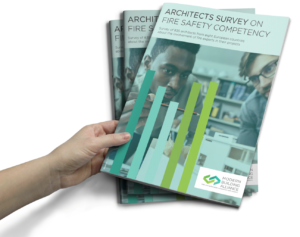 In June 2020, the Modern Building Alliance commissioned the USP Marketing Consultancy to launch a survey targeted at architects from eight European countries: Belgium, France, Germany, Italy, The Netherlands, Poland, Spain and the UK. The survey aimed to discover how fire safety competencies are considered during the building design phase. A sample of 835 architects, working in offices composed of at least two architects excluding smaller projects, responded. The majority are primarily focused on residential buildings and engaged in both new builds and renovations.
In June 2020, the Modern Building Alliance commissioned the USP Marketing Consultancy to launch a survey targeted at architects from eight European countries: Belgium, France, Germany, Italy, The Netherlands, Poland, Spain and the UK. The survey aimed to discover how fire safety competencies are considered during the building design phase. A sample of 835 architects, working in offices composed of at least two architects excluding smaller projects, responded. The majority are primarily focused on residential buildings and engaged in both new builds and renovations.
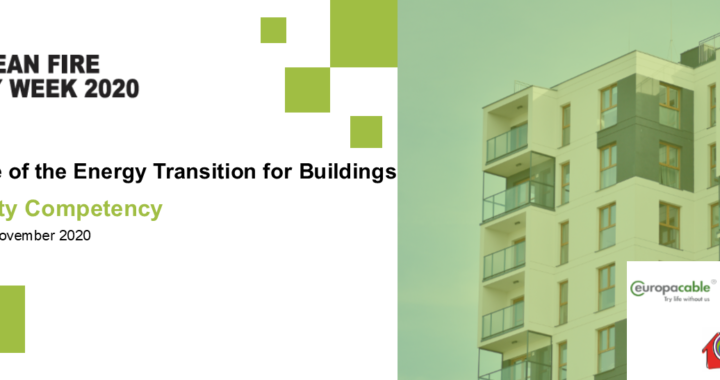


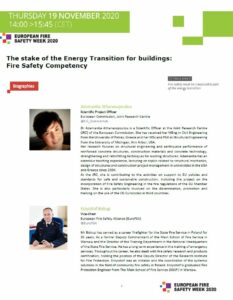
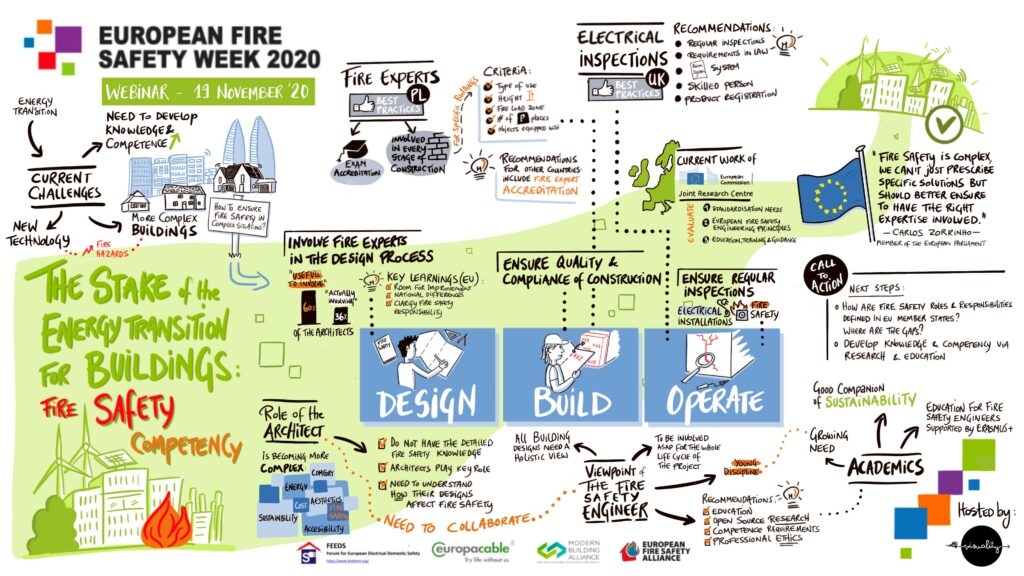


 Alarms are vital Installation products to ensure early evacuation in the case of a fire. The use of smoke alarms is determined by national codes and varies from one country to another. This factsheet highlights the state of current national requirements on smoke alarms.
Alarms are vital Installation products to ensure early evacuation in the case of a fire. The use of smoke alarms is determined by national codes and varies from one country to another. This factsheet highlights the state of current national requirements on smoke alarms.